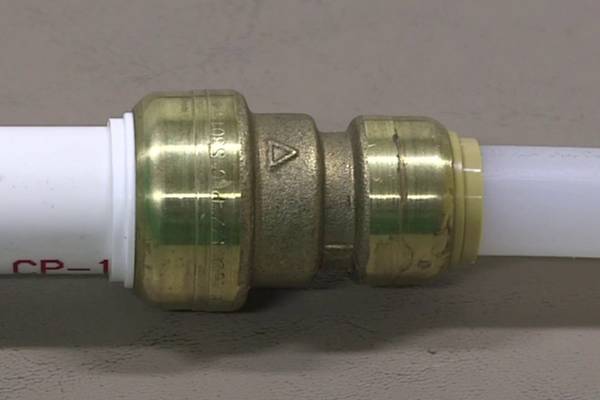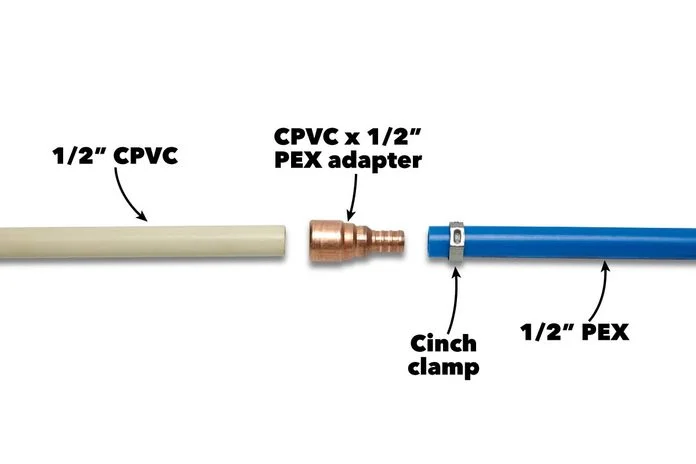Can You Glue PEX to CPVC
Several types of pipes are used in plumbing, each with benefits and drawbacks. Despite their similarities, PEX and CPVC should always be separate. What about joining PEX and CPVC with glue? The foundations of the topic at hand will be laid here.
What are PEX and CPVC?
The flexible plastic tubing known as cross-linked polyethylene (PEX) is corrosion-resistant and has a low installation complexity. Because of its durability, malleability, and resilience to high heat and pressure, PEX has earned a stellar reputation. It is commonly used in radiant floor heating, hydronic heating systems, and pipes transporting hot and cold water.
In many modern structures, chlorinated polyvinyl chloride (CPVC) piping carries hot and cold water. CPVC is suitable for harsh conditions because of its durability and resistance to corrosion and heat. It can be used for both commercial and residential plumbing.

Compatibility between Plumbing Fittings
Most popular PEX plumbing fittings come with a crimping device connecting the tubing. In various types of connections, compression rings and nuts seal the tubing with the fitting. Solvent-based glue is used to join the CPVC pipes with the fittings just like its usage for fiberglass and related material joining. Solvent-based glue will soften the PEX tubing, causing the connection to fail. The PEX material is flexible and not compatible with CPVC fittings. This is because the rigid plastic can’t be crimped in place to use a crimping device, and a compression ring for a fitting won’t spread out enough to work.
Push fittings are compatible with various plastic pipes, including PEX and CPVC. These fittings have an O-ring that seals pipes against the built-in gasket. They are similar to quick-release couplings for air or water hoses. The fitting is inserted with PEX tubing on one side and CPVC on the other. This connection can be made without glue or any special equipment required for CPVC and PEX plumbing systems.
Converging PEX and CPVC Pipes
Incorrectly joining PEX and CPVC can lead to leaks and other problems in the plumbing system. You’ll require a unique transition fitting to enter these materials. Brass is a popular material for making these fittings with two ends: PEX and CPVC. They allow for a watertight connection between the two types of pipe.
Avoiding Disaster: Why You Shouldn’t Glue PEX to CPVC
If you glue PEX to CPVC, you’ll likely encounter many issues. They are constructed of different materials, so you can only glue them together. Doing so would cause leaks, cracks, and other problems. Second, if an unsuitable connection is made, it may violate local building codes, leading to costly fines and repairs. Lastly, plumbing problems can be expensive and even dangerous if someone is hurt.
Getting Deeper Into PEX and CPVC
Due to their strengths, PEX and CPVC pipes best suit specific plumbing applications. While CPVC piping is difficult and time-consuming, PEX piping is adaptable and straightforward to set up. PEX is used more frequently in home plumbing than CPVC because of its simplicity and low installation cost compared to its commercial counterpart.
PEX pipes are readily available in a rainbow of colors and sizes, making it easy to choose the perfect match for your home’s plumbing system. These adapters allow for various connections, including push-to-connect, crimp, and compression. The chlorine and other chemicals used in plumbing systems do not affect PEX.
However, there is a restricted selection of sizes and colors for CPVC pipes. You’ll need primers, solvent cement, and other specialized tools and processes to join the pipes and fittings. CPVC pipes are more susceptible to damage from subfreezing temperatures and ultraviolet light than PEX pipes are.
While picking between PEX and CPVC for your plumbing system, it’s important to consider its specific needs. If you need a pipe that can withstand high heat and pressure yet is still simple to install, PEX may be your best bet. If you require a robust line for industrial plumbing, CPVC may be the best solution.
While PEX and CPVC pipes have extensive use in the plumbing industry, they are different. Because of the risk of leaks, attempting to glue PEX onto CPVC is not recommended. Always use a transition fitting designed for linking PEX and CPVC pipes together to prevent leaks and other issues.
How do you connect PEX and CPVC together?
Plumbing has seen a rise in the use of push fittings. Push fittings are available at many home improvement stores.
These pieces may be a little expensive but cheaper than replacing fittings that keep breaking.
Imagine being forced to move the entire plumbing system to another system due to compatibility issues.
The cost of buying push fittings would have been much higher. You can reuse these fittings, so you don’t need to purchase new ones if you make a mistake.
Be sure that the pipes are clean before connecting PEX or CPVC.
Look for visible cracks or damage. Remove them, if possible, with a razor on PEX piping and sandpaper for CPVC piping.
For a good seal, the end of the pipe going into the fitting must be smooth. Then, push the push fitting into the CPVC until it cannot go any further.
Press the opposite side of the push-fitting on the PEX tube after you have installed the rigid CPVC. Turn on the water to see if there are any leaks.
You can connect two PEX systems using “SeaTech,” “Sharkbite,” and “Rainbow” fittings. Under no circumstances can you seal, weld or attach PEX pipe pieces directly.
Connect PEX to PEX by following the steps below:
- Remove excess PEX tubing
- Slide the PEX crimp rings over the tube about 2 inches beyond the end.
- The PEX fitting should be pushed into the PEX tube all the way.
- Place the PEX crimp rings at a distance of about 1/8″ to 1/4″.
- Use the PEX crimping tool to open the jaws.
You must repair any leaks that may occur after connecting the two tubes. Follow the steps below to do this:
- Use the PEX tubing cutter to remove any damaged sections of the PEX tubes
- Prepare a piece of PEX tube that is longer than the length you will need for the repair
- Use the Crimp Connection method to connect the tubing and the fitting, then test the connection with the Go-No Go gauge
You’re done. You’ve now repaired the leaks and connected PEX tubing to PEX. If you find more leaks, repeat the process.
If you follow the instructions, your hose should not leak anymore.

Conclusion
Gluing PEX to CPVC pipes is currently not supported by enough data to warrant its use. Because of their dissimilar materials and chemical compositions, joining PEX and CPVC pipes may be difficult and result in a leak. Because of the incompatibility of some adhesives with PEX and CPVC, gluing these two materials can be very challenging. This is why it’s recommended to use transition couplings or fittings that allow you to join PEX and CPVC pipes without adhesive.
Frequently Asked Questions
Can you glue PEX to CPVC?
You can’t. Solvent-based glue will melt the PEX tube and cause the connection to fail.
Can you join PEX directly to PVC piping?
You can connect PEX to PVC directly with the right type of fitting. For example, a half-inch PEX pipe will fit in a push fitting that is half an inch. Although the fittings are expensive, they are cheaper than having to repeat mistakes or relocate all plumbing lines to be compatible with another system. Fittings can be replaced if a mistake or the system changes.
Does using a Push-Fit on both sides of the connection make sense?
Push-fits can be used on both sides of the connection. This type of fitting comes in various sizes that fit both PEX and CPVC pipes.

Being associated with art and craft field since decades as a hobbyist and life long learner has given me an opportunity to learn many new things related to art, craft, paints and pottery which i am trying to share with your guys on this website. I have expertise of being professional painter and potter for the last 20+ years
I have learned mind blowing cool tips and insights which makes me a person with ability to improvise and come up with creative ideas and solutions to make stunning and impeccable art pieces of all types which are adored by people across the globe on this website and other platform.


